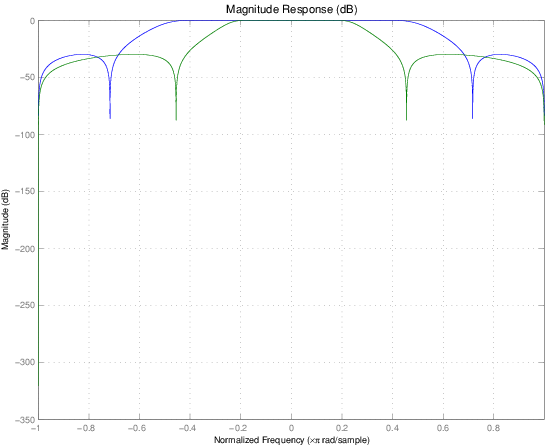zpklp2xc
Zero-pole-gain lowpass to complex N-point frequency transformation
Syntax
[Z2,P2,K2,AllpassNum,AllpassDen]
= zpklp2xc(Z,P,K,Wo,Wt)
Description
[Z2,P2,K2,AllpassNum,AllpassDen]
= zpklp2xc(Z,P,K,Wo,Wt) returns zeros, Z2,
poles, P2, and gain factor, K2,
of the target filter transformed from the real lowpass prototype by
applying an Nth-order real lowpass to complex multipoint
frequency transformation.
It also returns the numerator, AllpassNum,
and the denominator, AllpassDen, of the allpass
mapping filter. The prototype lowpass filter is given with zeros, Z,
poles, P, and gain factor, K.
Parameter N also specifies the number of
replicas of the prototype filter created around the unit circle after
the transformation. This transformation effectively places N features
of an original filter, located at frequencies Wo1,...,WoN,
at the required target frequency locations, Wt1,...,WtM.
Relative positions of other features of an original filter are
the same in the target filter for the Nyquist mobility and are reversed
for the DC mobility. For the Nyquist mobility this means that it is
possible to select two features of an original filter, F1 and
F2, with F1 preceding
F2. Feature F1 will
still precede F2 after the transformation.
However, the distance between F1 and F2 will
not be the same before and after the transformation. For DC mobility
feature F2 will precede F1 after
the transformation.
Choice of the feature subject to this transformation is not
restricted to the cutoff frequency of an original lowpass filter.
In general it is possible to select any feature; e.g., the stopband
edge, the DC, the deep minimum in the stopband, or other ones. The
only condition is that the features must be selected in such a way
that when creating N bands around the unit circle,
there will be no band overlap.
This transformation can also be used for transforming other
types of filters; e.g., notch filters or resonators can be easily
replicated at a number of required frequency locations. A good application
would be an adaptive tone cancellation circuit reacting to the changing
number and location of tones.
Examples
Design a prototype real IIR halfband filter using a standard
elliptic approach:
[b, a] = ellip(3,0.1,30,0.409);
z = roots(b);
p = roots(a);
k = b(1);
[z2,p2,k2] = zpklp2xc(z, p, k, [-0.5 0.5], [-0.25 0.25]);
Verify the result by comparing the prototype filter with the
target filter:
fvtool(b, a, k2*poly(z2), poly(p2));
Plotting the filters on the same axes lets you compare the results
graphically, shown here.

Arguments
VariableDescriptionZZeros of the prototype lowpass filter
PPoles of the prototype lowpass filter
KGain factor of the prototype lowpass filter
WoFrequency values to be transformed from the prototype
filter. They should be normalized to be between 0 and 1, with 1 corresponding
to half the sample rate.
WtDesired frequency locations in the transformed target
filter. They should be normalized to be between -1 and 1, with 1 corresponding
to half the sample rate.
Z2Zeros of the target filter
P2Poles of the target filter
K2Gain factor of the target filter
AllpassNumNumerator of the mapping filter
AllpassDenDenominator of the mapping filter
Introduced in R2011a
最后
以上就是高高蜻蜓最近收集整理的关于matlab里的zpk,Zero-pole-gain lowpass to complex N-point frequency transformation的全部内容,更多相关matlab里的zpk,Zero-pole-gain内容请搜索靠谱客的其他文章。








发表评论 取消回复